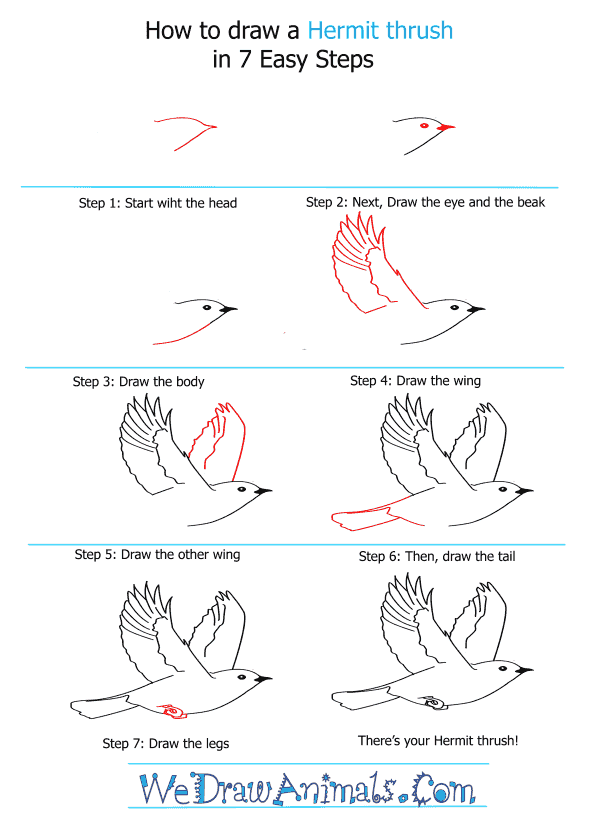In this quick tutorial you'll learn how to draw a Hermit Thrush in 7 easy steps - great for kids and novice artists.
The images above represent how your finished drawing is going to look and the steps involved.
Below are the individual steps - you can click on each one for a High Resolution printable PDF version.
At the bottom you can read some interesting facts about the Hermit Thrush.
Make sure you also check out any of the hundreds of drawing tutorials grouped by category.
How to Draw a Hermit Thrush - Step-by-Step Tutorial
Step 1: Start with the head and add in the outline of the beak for our hermit thrush.
Step 2: Add more detail to the face - a line on the beak and a very small almond shape for the eye.
Step 3: Now add the underbelly. Draw a long, curved line beginning at the base of the thrush's throat.
Step 4: Now draw the wing. Start with a straight line and then make it a fan shape. Add the sprouting for the wings!
Step 5: Mirror this wing by drawing another one on the other side of the thrush.
Step 6: Now draw the tail, long and straight. This common in all thrushes, round heads and long tails!
Step 7: Let's give our thrush some legs! Draw two small hooks to indicate the bird's feet.
Interesting Facts about Hermit Thrush
The Hermit Thrush will live in a variety of areas including boreal forests to the far northern sections of North America to mountain and deciduous forests. They will be inside open forest areas such as pond edges, trails and mountain glades.They occupy the lower-elevation forests with berry bushes and dense understory including pine, broadleaf evergreens, and deciduous woods. They have been seen near streams and urban lawns in Mexico as well.
Did you know?
- Short distant migrants as they are mean they are the last to leave in the fall and first to arrive in spring.
- Sometimes they will grab a branch and shake it with their foot to find insects to eat.
- East of Rocky Mountains, they will nest on ground while in the West they will nest in trees.
- In spring they will eat beetles, bees, ants, caterpillars and flies. In the winter they will choose fruit and wild berries.
- The males will gather food for the nest and the female will feed the nestlings which are fed larvae, grasshoppers, moths and spiders.
Females will build a nest from grass, leaves, pine needles and bits of wood, they will line it with mud and lichen on the outside. Inside the nest will be lined with plant materials and willow catkin. The finished nest is 4-6 inches across, 2-3 inches wide and 1-2 inches deep.








